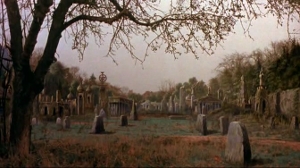
Clive Barker’s Nightbreed by Clive Barker is a horror film based on the 1986 novella “Cabal,” written by some British dude named…Clive Barker…huh…Funny: the writer of the source material and the writer/producer/director of this film share the same name…almost as if they’re…gasp…the same person! But no…that’s so outlandish a concept it couldn’t possibly be true…could it?
Cabal‘s a product of what Barker scholars (i.e., the five or six voices in my head who claim to specialize in his work) refer to as his “middle” period. By 1990, the once-poor English playwright (and how Byronic can you get?) was an international sensation, alternatively praised and maligned as “the British Stephen King.” But whereas King takes us into the minds of old Twilight Zone and Outer Limits protagonists, Barker built his career on taking us into the minds of their monsters.
As such, Barker became famous for directing Hellraiser, despite writing a small shelf’s worth of other, much better books. Barker’s a stranger cat than King could ever hope to be. For one thing, he’s got a bigger imagination, unconstrained by the knee-jerk prudishness of American Protestantism. Like Lewis Strack, Barker likes to ask, “What do you think, Julie? Who’s the real monster here?” And like Strack, Barker’s fond of answering his own question in the most obvious and bombastic ways.
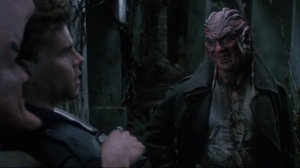
That’s not a criticism. Just an observation that Barker lacks what the Masters of Hollywood’s Universe call “built-in mass appeal.” He goes for what the 80s considered “the gross-out” even though his gross-outs look tame by today’s torture porn (yeah, sorry, Mr. Jones, but that’s what it is) standards. 1990’s “shocks” comes off as merely “jarring.” Like the dream sequence that opens things up with a parade of cave paintings, monsters and apocalyptic tableaus.
Which turns out to be the nightmare of Our Hero, Aaron Burr Boone (Craig Sheffer, whom you might recognize from A River Runs Through It). Boone’s your usual Clive Barker protagonist: a yuppie with some strange connection to the Occult Underworld beneath our drab perceptions of everyday reality. You know how it is. One day, you’re on top of the world. You’ve got the hot girlfriend, Lori (Anne Bobby, whom you probably won’t recognize as the voice of the BioShock‘s Brigid Tenenbaum without her German accent), no job to speak of, and a swank apartment miles wider than any starving artist outside the Opulence Dimension. The next day, your therapist (David Motherfucking Cronenberg!) is telling you about how the cops came to him with several grisly murders. Murders very similar to those you described as “dreams” during your hypnotic therapy sessions. Would you like to hear the tapes? The cops left pictures! Wanna see?
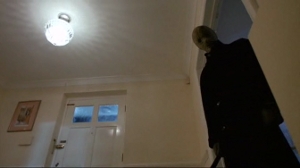
I’m not even exaggerating. Cronenberg plays one of the creepiest psychologists I’ve seen outside of Gotham City. Hell, I’m pretty sure either Chris Nolan, Cillian Murphy, or somebody based Murphy’s Scarecrow on Mr. Cronenberg’s creepy-crawly performance here. He’s as purposefully off-putting as the openings of his films. Would you tell your innermost secrets to the director of Shivers, The Fly and Videodrome? Really? He looks a man who sits at home studying his knife collection in his Special Chair…the one flanked by the twin waterfalls of blood.
But in this universe, Cronenberg’s passing himself off as Dr. Phillip K. Decker (no really, that’s his character’s name), who gives Boone the bad news and a complementary bottle of pills. C’mon: he’s The Killer, right? I mean, that’s why you cast him, isn’t it, Clive? Certainly couldn’t have anything to do with his natural range as an actor (which stretches from “off-putting” to “bland”…when he’s out of costume, at least) or all that lovely money his name attracted to this project…could it?
Either way, overcome with guilt at his supposed crimes and dosed to the gills on what the MT’s call “medical grade hallucinogens,” Boone attempts suicide. He fails, but runs headlong into the rest of the plot at hospital in the person of Narcisse (Hugh Ross). Despite looking like your standard issue hobo, Narcisse ingratiates himself to Boone by rambling about Barker’s version of the Big Rock Candy Mountain: Midian. Which is funny, since Boone’s dreamed about such a place for months. Mistaking him for an agent of Midian, Narcisse tells Boone where to find it. But before they can leave, Narcisse insists on proving himself worthy of Midian by revealing his true form…i.e., tearing the flesh off his own head.
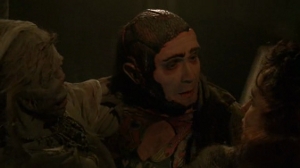
Escaping the resulting chaos, Boone finds Midian: an overgrown graveyard tucked into some forgotten corner of the Canadian Rockies with no nearby town to provide fresh tenants or keep the ivy from strangling the statues. Tired of running, Boone makes the classic mistake all fantasy protagonists make and lays down for a quick nap.
Awakened after dark, Boone’s quickly accosted by two native Midianites. Like we Daybreed, they openly refer to themselves as “monsters,” and when Boone tries to qualify for citizenship by claiming he’s killed a small busload of folks, the real monsters pishaw his crimes away. The talkative one with the red skin and the dreadlocks – Peloquin (Olive Parker) – would’ve laughed Boone all the way back through the cemetery gates if he weren’t so hungry and Boone weren’t so obviously innocent “meat…for the beast.”
Through the good graces (and directions) of another “monster,” Kinski (Nicholas Vince), Boone escapes Peloquin with nothing worse than chunk missing from his shoulder. But – aww, snap – it’s out of the haunted cemetery and into the cop’s line of fire, as Boone finds Decker and the whole host of lawmen from the nearby town of Shareneck waiting right outside. Decker makes like a man trying to calm Boone down only to cry out, “He’s got a gun!” at the last second. This dick move assures Boone’s “suicide-by-cop,” cementing his reputation as a mass-murdering psychopath.
This, obviously, leaves Lori in the worst kind of lurch. Refusing to believe her lover spent months moonlighting as Michael Myers, she’s not sure what to think when Boone’s “corpse” disappears from the Shareneck morgue. So she, too, goes to Midian. But at least she had the good sense to bring a friend, Sheryl Ann (Debora Weston), and schedule her visit for the middle of the day.
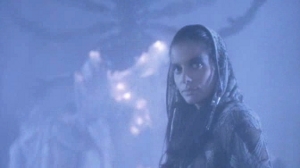
There she finds a stiff-looking, rod puppet creature apparently dying in a shaft of sunlight. Despite looking like a refugee from one of Seth Brundle’s telepods, a woman in the doorway of a mausoleum (Catherine Chevalier) insists Lori bring the creature to her. Overcoming the heebies-jeebies, Lori does, and once inside, the creature transforms into a little girl (Kim Robertson) and the woman comes out as her mom, Rachel. A grateful Rachel promises Lori anything in return, but all Lori wants is Boone. And now that he’s officially undead, that’s the one thing she can’t have.
See, Midian serves as these creature’s last refuge from a world that hates them, fears them and almost hunted them to extinction at some vague point in the past. In Midian they live in peace under the very Mosaic leadership of Lylesberg (Doug Bradley), guided by the Laws they’ve received from their god, Baphomet, Who Made Midian (voiced by Bernard Henry).
You hear a lot about “The Law” in this movie. I suspect Doug Bradley got this gig on the strength of his ability to say “That is the The Law” with a suitably booming amount of gravitas. The Law constrains Boone from rejoining Lori in the Overworld and it keeps Lori from from joining him Down Below. Thankfully, Boone takes the 20th century human view that laws are made to be acknowledge then ignored. Man’ll ignore any law for the chance to lay his Love Interest.
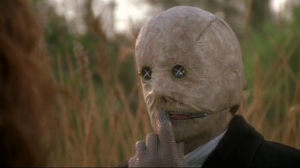
Or rescue her from his murderous ex-shrink, as in this case. Because not only is Dr. Decker The Killer and the Villain of our piece, Boone’s death and resurrection put him on a Villainous Quest for the Truth. He followed Lori up to Midian in the hope of finding it (and slicing up the one loose end in his master plan to frame Boone up) and boy, howdy, does he ever.
With Lori brought below in flagrant violation of The Law and Dr. Decker sent back toward town screaming and (even more) insane, Boone must convince the Nightbreed that this whole “cower in obscurity and hope no one notices us” thing isn’t really working…and it certainly won’t help solve the problem Boone’s brought down upon their heads with his impulsive rescuing of a Damsel in Distress. Back in the town, Dr. Decker’s already hard at work convincing the redneck denizens of Shareneck to form a gun-totting mob and clean out that ancient cemetery up on the hill. Don’t ‘cha know there’s crazies up there? They could even be (gasp) cultists!
Frequent commenter Filip Önell sold me on this by describing it as “the anti-Avatar.” He’s right, in that this is another Magical Boy story. You know the drill: anonymous schlub rises from obscurity and lives through extraordinary events, only to find out that he’s The One, prophesied to save the world…or, at least, that part inhabited by whatever micro-society’s making up the prophesies this week. Like every Messiah, Boone struggles with the unfortunate fact that sometimes “saving” a world and “destroying” it aren’t mutually exclusive. Sometimes both amount to pretty much the same thing: a whole lot of suffering for everyone involved, be they human or demihuman, living or undead.
There’s a skein of purposeful nods to the Old Testament layering this cake, elevating what would otherwise be your typical, 80s monster movie into what Joseph Campbell called “mytho-poetic territory.” The serious biblical scholars in my audience (both of you) probably recognized this as soon as you saw the name “Midian.” It’s where the Burning Bush first told Moses, “Get off your ass, son! Get ta bus’in’!” and it’s where Baphomet, Who Made Midian, charges Boone with the responsibility of leading the Nightbreed to a new home, rechristening him “Cabal, Who Unmade Midian.” Because even Baphomet Who Made Midian feels naming your hero “Boone” (as in, the Ultimate one Heroes bestow on their societies upon completion of their Journey) was a little too on the nose.
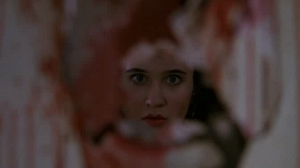
That’s the thing about Barker: he uses murder and monstrosity the same way a young George Lucus used special effects, dressing up an ancient story in modern trappings he hopes will distract you from the nagging suspicion that you could write this in your sleep. As with Star Wars, it’s the execution (no pun intended) that counts, and despite this film’s reputation as a flop (it cost $11 million to make and only took $8 million back during its theatrical run) I’d call Nightbreed “a flawed success.”
For one thing, its the most-faithful adaptation of Barker’s work since Hellraiser. No small task, since Cabal‘s a far more complex story, with multiple, constantly shifting POVs on top of its attempt to “humanize” monsters and examine the underlying monstrosity of so-called “normal” humans. Barker fixed my big problem with his novella (the pace) by trimming most all of its scenes down to their musty skeleton. The novella’s two sex scenes are excised completely…and someone better check the temperature in Hell because – for once – I’m actually glad to see them go. Even by mid-80s, Clive Barker standards, those two bits of T&A were gra-fucking-tuitous.
But all that trimming comes at the expense of character development. And here’s where I really break Hell’s thermometer by agreeing with the Great Film Critic Consensus: Nightbreed’s characters are all flat. They’re archetypes, befitting their mythic storyline. Boone’s the boon, Decker the Evil Father Figure, and almost all the Midianites are defined by their (quite nice, I’ll grant you) practical make-up effects.
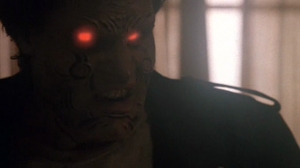
Watching this movie, you can see how reliant on narration Barker really is. Characterization through dialogue’s never been his strong point, since his characters spend the vast majority of their time either explaining or reacting to something fantastic. Most of their growth occurs internally and, until someone invents Telpath-o-Vision, that’s the kind of growth films will need to spend the most time on. Because film must show what prose can just tell and move the hell on.
For a movie with this much going on, Nightbreed is criminally short. It attempts to run Boone through a full Hero’s Journey against a rich, mythological backdrop that encompasses radical revisions of nearly every major monster archetype in Western folklore. Werewolves, vampires, shape-shifters, ghouls, zombies, men in rubber suits. They’re all here. And if that’s not enough, here’s David Cronenberg, playing Barker’s half-satirical version of a Slasher. That’s way too much for an hour and forty-five minutes.
That’s not all its fault. Barker conceived this as the first act in an Epic Horror/Fantasy Trilogy to end all Epic Horror/Fantasy Trilogies. Too bad his timing sucked. Studios don’t really know what to make of Barker’s stuff at the best of times, and Morgan Creek studios fucked Nightbreed from the start by planning its release in for August, 1989…smack in the summer of Batman. That was such a dumb idea even the studio heads realized it and Nightbreed got pushed back…to the Movie Dead Zone we call “February,” when studios put out the shit even they recognize as shitty.
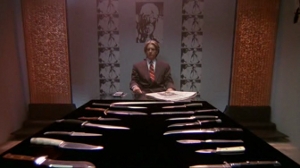
The studio used that time to ring Nightbreed through multiple test screenings, ordering massive re-cuts after each and every one. The original cut of the film was apparently two and a half hours long…and strange as it sounds, that actually makes sense given all the underdeveloped characters running around in the background. The film’s distributor, Fox, told Barker to cut an hour out, because shorter films mean more screenings per day and thus more money. Barker argued for a two hour cut, which apparently exists in some Fox vault somewhere, but still the Almighty Dollar was not pleased. Eventually, after editor Richard Marden resigned in protest, this hundred and two minute cut limped into theaters.
And it is a wounded animal, trapped in the midst of shapeshifting. About five minutes in, a pointless, two-minute Slasher Movie intervenes between the introductions of our main hero and main villain. Sure, the collection of Jump Scares introduces us to ol’ Button Head…but so does the very next scene. And at least it advances the plot.
Side characters? What side characters? Human or otherwise, they were obviously the first to feel the editor’s knife. The novel’s rich supporting cast becomes visual background noise, fodder for either Dr. Decker’s Mask (if they’re human…and female…and especially if they’re the Hero’s Girlfriend) or (if they’re Nighbreed) the torch-wielding mob who’s rampage through Midian sets up the Climactic Battle.
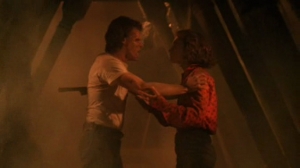
And it’s one hell of a Climactic Battle. It is, in all sincerity, the Climactic Battle a certain generation of horror fans grew up waiting for. Who among you didn’t wish Frankenstein’s Monster would, just once, turn around and plow through the mob of yahoos on his trail? Well, imagine that with as many explosions and monster costumes as eleven mil could afford in 1989. The eternal battle between peasants and their own folklore hasn’t look this good since…well, really, ever.
Besides that, not all is grim and gritty. For a horror/fantasy, what comic relief their is comes off remarkably well. Once we get to Midian, things are creatively weird enough to hold our interest. As we wander its hallways with Lori, we get to react with her, and see our reactions reflected in her, softening the transition from Boone’s POV to hers (and back again). Once David Cronenberg puts on his Mask, we know exactly why Barker cast him. He’s a perfect masked psychopath: the kind that never makes lame puns. When he speaks through the Mask he speaks with purpose and cold calculation, reflecting a detachment from humanity the Mask symbolizes. With it, he becomes a genuinely good villain, something most of these Dances with ____ movies are missing.
You see? Even after the studio hatchet job, little touches of Nightbreed‘s potential brilliance shine through, showing this was meant to be more than another late-80s, revisionist monster film. I’ve heard Barker meant it to be the genre’s Star Wars. You’d think Fox (which owns Star Wars) would’ve thrown their full weight behind such a thing.
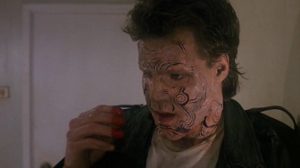
Unfortunately, this movie freaked Morgan Creek’s head of Marketing right the fuck out. So much so that he reportedly refused to sit through all of it. This has to be the funniest thing I’ve read all month, considering the movie’s relatively sparse gore and almost complete lack of nudity (and most of that‘s covered by latex and body-paint). I can only surmise that Image Animation’s excellent creature designs were just that freaky. Poor man obviously never toured Stan Winston’s studios. Or the set of his own company’s film. The one they spent two years and $11 million making? Yeah, that one.
Instead of doing their job, Morgan Creek marketed the film like any old horror movie. So it’s initial take sucked. It’s since gone on to grow an obvious cult following, so consider this one critic adding his voice to the chorus. If you like monster movies, Hellraiser, Barker’s work in general, or have ever felt the urge to say, “Fuck the law, I want meat!” give Nightbreed a go. I liked it a hell of a lot better than Avatar. Or Dances with Wolves.
![]()
![]()
![]()
![]()
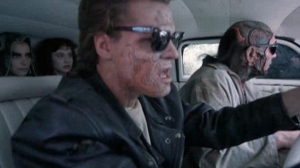

I’ve always liked this one better than Hellraiser or…ugh…Rawhead Rex. It’s on par with Lord of Illusions in my opinion, though I understand why LoI isn’t generally well liked.
Anyhow, screw the movies, where’s my 3rd Book of The Art?
Indeed. Yours and mine both. Apparently Barker’s been side-tracking himself these last few years, trying to get the The Abarat Quintet made into a movie. Silly man went and pitched the idea to Disney, of all fucking people, then went and topped that by actually sticking around to try and make something of the project.
I also like to think of Nightbreed as Clive Barker’s superhero entry. His X-Men. Oh yeah, and one of the scenes cut from the film is Lori stabbing herself with Decker’s knife at the end. A dying Lori then tells Boone to bite her. Boone refuses at first, but when she dies, he decides to bite her, and she comes back to life as a Nightbreed. I think that would also have made this movie anti-Twilight. lol
Yeah, the studio didn’t get the film. I’m not sure why Barker didn’t approach New World Pictures with this project, since he made Hellraiser 1 and 2 with them, and they couldn’t care less what Barker was doing. I think if Barker made Nightbreed today, studios (Lions Gate?) would get it and audiences would like it. The people in charge over at Morgan Creek are idiots. Just look at The Exorcist III…
What good came out of Morgan Creek’s changes are the re-shoots with Decker. I like the opening sequence with the family. Its kind of pointless, sure, but freaky as hell. Those 2 minutes are scarier than any slasher flick I’ve seen. There’s the scene where Decker interrogates John Agar; it fleshes out his character. When I first saw the movie I didn’t think Cronenberg would play a major role in the movie. I mean its director David Cronenberg. I thought it was just a 5 minute cameo as some psychiatrist…
Guillermo del Toro should totally make a new Nightbreed movie.
And if the remake is a success, maybe that will get Morgan Creek to release Barker’s Director’s Cut…
That would be twelve kinds of awesome. Even an DVD extra would be better than nothing. If they can dredge up thirty minutes of “lost” footage from Superman IV: The Quest for Cash nothing is impossible. del Toro would be the perfect choice, provided he could focus long enough to carry it through. But he’s worked well with auteur writers before, and this is as close to a “magical realism” movie as I’ve seen any Anglo produce in quite some time.
And now I’ve got the urge to watch Pan’s Labyrinth again.
Good review of Nightbreed I wanted to share.
http://homecinema.thedigitalfix.com/content.php?contentid=58990
And, as usual, I’m glad you did, because it’s awesome.
I’ve always wanted to see Nightbreed redone as a tv series. Especially now that we have shows like Game of Thrones and Spartacus to set the bar by for perversity, blood-letting, and big, expensive stories. I think three seasons, 1 being the novella adapted into 8-10 episodes with FULL exploration of the history and characters, 2 being the search for a new home on the part of our heroes while trying to navigate a world most of them remember very differently (being immortal and all), and 3 being the fight for their new home and to preserve their existence as they question whether they even should. I think it could be beautiful and disgusting and fascinating and moving, like Barker’s work tends to be at its best.
Excellent examination of this often overlooked film! I never really thought about the parallel with a Dances With Wolves type of storyline, but that absolutely makes sense. And the “average-guy-finds-hidden-powers-and-becomes-the-chosen-one-of-a-tribe-of-weirdos” angle is certainly what fascinated me the first time I saw it as a teenager. Upon repeat viewings and learning more about Mr. Barker himself, I started to see it more as a thinly-veiled parable about lifestyle persecution and the importance of coming out of the closet, where the Midian monsters represent the LGBT community, and the “normal” humans (the real monsters of the film) represent bigots and hate groups. The monsters’ sexuality is pumped up to the max, which can lead to some of the movie’s campier moments (Narcisse’s line, “Hey, sailor. Love the tattoos!” for example) as well as some of its more darkly poetic imagery (Shuna Sassi seductively luring the bad guys toward her during the climactic battle, only to kill them a moment later, seeming to revel in their deaths). Lylesberg could be said to represent the attitude of the gay community in the 1950s (stay hidden, it’s the only way to survive) vs. Boone’s insistence that the Nightbreed can’t hide anymore and must stand and fight, representing a more modern attitude. I also find it interesting that Decker talks about how he’s killed “a lot of breeders, filth making filth making filth,” sort of an argument against the Puritanical idea that making babies is the only natural reason to have sex; Decker actually sees reproduction itself as the perversion. Anyway, I could go on and on about the underlying sexual tones of Barker’s movies (Cenobites = S&M enthusiasts in Hellraiser; Nix lamenting that he and D’Amour were supposed to “keep each other company in the darkness” in Lord of Illusions) and that’s part of what makes them so fun to watch, since all great horror movies find a way to walk a tightrope between sex and death. It’s just that Barker’s movies tend to make the sex part much more noticeable than usual. Plus, in this one, there’s a fat guy who shoots snakes out of his gut. Anyway, thanks for writing a great article, Mr. DeMoss, and allowing me to throw in my two cents! And thanks to Filip for pointing me here.
Indeed, Filip’s good people, and he directs good people here. Thanks to my background, I get a strong “W.E.B. Du Bois vs. Marcus Garvey” vibe off Boone and Lylesberg, but a “pre- vs. post-Stonewall” reading fits the text much better. Having met actual S&M enthusiasts in the sticky, nuanced “real” world, I’m no longer certain quite what the Cenobites represent…but, with nine of those fucking movies extant at the time of this writing, we’ll have more than enough time do hash that out.
From the first time I read Hellbound Heart, I’ve admired the omnisexuality of Barker’s stories. Like I said, we Yanks are strangled by the fact our nation was founded by people too uptight for the English to deal with on their own soil. Stephen King’s heart is a battlefield between competing strands of hard line Puritanism and the French Catholicism he married into. Dean Koontz, being an Orange County, California, Republican, is even worse, and seems to become more of a prude as time goes on and the world leaves him behind. He’s gone so far as to deny (more than three times) cutting his teeth on cheap, paperback erotica in the early 70s…as if writing porn were something other than the go-to source of income for struggling, no-name authors of the time. Something to be embarrassed about. We’re too easily embarrassed, is our thing, and to a mind soaked in that from birth, Barker’s frankness (and that of a few of his Brit Pack contemporaries, like Lumley) is like a breath of fresh air. Problem being it smells like a mausoleum to most of the so-called “normal” people. (I always think of that restaurant scene in Ghostbusters 2: “Boys, boys – you’re scaring the Straights, okay?”) And while watching their reactions to Barker’s stuff is almost as entertaining as the Art itself, I eventually realized, “Damnit – if this is how they take the relatively tame stuff, I’m never going to get my Great and Secret Show movie.” Man who shoots snakes from his gut? Hell, call me when they cast Nick Nolte as Kissoon and Weta workshop starts doing concept work on his hut…and his Lix.